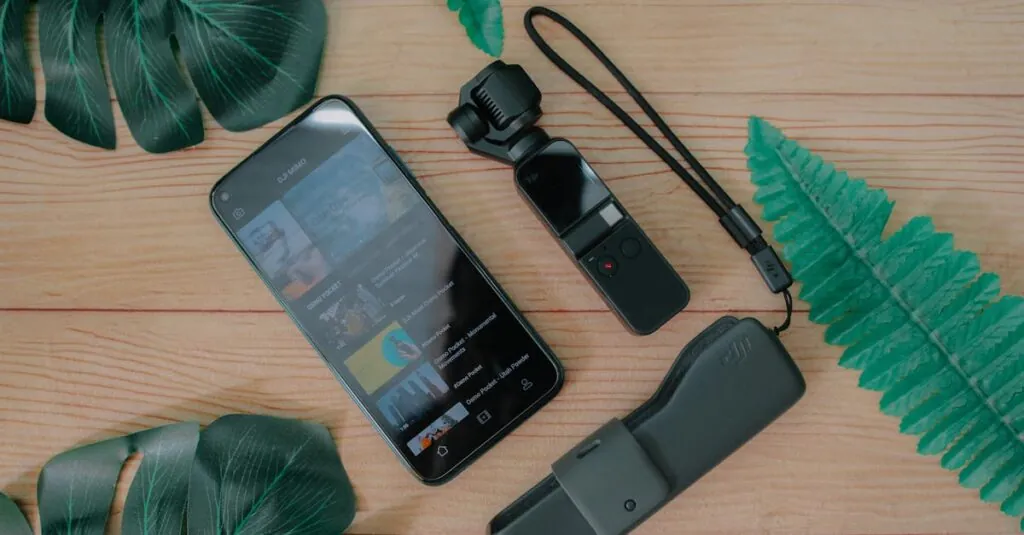Table of Contents
ToggleIn a world where first impressions matter, the app interface is your digital handshake. If it’s clunky or confusing, users might just turn on their heels and walk away faster than you can say “user experience.” Crafting a seamless setup app interface isn’t just about aesthetics; it’s about creating a welcoming environment that invites users to explore.
Imagine a place where every tap feels intuitive and every swipe brings joy. That’s the magic of a well-designed interface—like a cozy coffee shop that makes you want to linger. By focusing on simplicity and functionality, developers can turn their apps into user-friendly havens. So let’s dive into the art of setting up an app interface that not only looks good but also keeps users coming back for more. After all, who wouldn’t want their app to be the life of the digital party?
Understanding Setup App Interface
A well-structured setup app interface streamlines user interactions and enhances overall user satisfaction. Focusing on clarity and ease of use fosters a more engaging experience.
Definition and Importance
A setup app interface refers to the initial layout and design users encounter when interacting with an application. This interface serves as a guide for users to seamlessly navigate functionalities. Importance stems from its role in setting the tone for user engagement, defining how users perceive the app. A well-crafted setup interface minimizes confusion and increases usability, encouraging users to explore the app’s features. Research indicates that a satisfying user experience can boost retention rates by up to 40 percent.
Key Components
Key components of a setup app interface include layout, navigation, and functionality. Layout determines how information is visually arranged, providing a coherent flow for the user. Navigation must be intuitive, facilitating easy access to features. Functionality refers to the responsiveness of buttons and other input elements, ensuring they work as expected. Consistency across these components helps reinforce user confidence. Analytics show that effective navigation can enhance user satisfaction by 30 percent, further highlighting the need for careful design considerations.
Best Practices for Designing a Setup App Interface
Designing a setup app interface involves several best practices that enhance user experience and engagement.
User-Centric Design Principles
Prioritizing user needs stands central to designing an effective app interface. Understanding target users fosters empathy and guides design decisions. Employing inclusive color schemes and accessible fonts improves visibility and comprehension for diverse users. Using familiar icons and terminology streamlines interactions. User testing reveals insights that refine the interface and align it with user expectations. Research shows that implementing user-centric design can improve satisfaction rates by up to 45 percent, demonstrating its significance in retaining users.
Streamlined Navigation
Navigation must be intuitive and straightforward to support seamless user journeys. Organizing content hierarchically enables users to find information effortlessly. Including breadcrumb trails and search functionality allows quick access to desired features. Keeping menu options limited minimizes cognitive load and confusion. Designers should ensure that all navigational elements are consistent across the app. Studies indicate that optimizing navigation can enhance user satisfaction by 30 percent, highlighting its critical role in maintaining engagement.
Common Challenges in Setup App Interfaces
Setup app interfaces encounter various challenges that can hinder user engagement. Understanding these obstacles is crucial for delivering an optimal user experience.
Technical Issues
Technical issues often arise during the setup of an app interface. Bugs can disrupt user flow, leading to frustration and abandonment. Incompatibility with different devices or operating systems presents another challenge. Developers face difficulties ensuring consistent performance across various platforms. Resource limitations may also affect the implementation of interactive features that elevate user experience. Effective testing procedures help identify and resolve these technical problems before launch, ensuring users enjoy a seamless entry into the app. Retaining user interest significantly relies on addressing these issues upfront.
User Experience Hurdles
User experience hurdles can impede the effectiveness of a setup app interface. Complicated navigation may confuse new users, causing them to struggle to find essential functions. Overloading the interface with information can overwhelm users, leading to disengagement. Simplifying the layout promotes clear navigation and eases the user journey. Another issue arises if the instructions lack clarity or relevance, resulting in misunderstandings. Implementing user feedback plays a vital role in overcoming these hurdles, as it aligns the interface with user expectations. Prioritizing simplicity and intuitiveness greatly enhances the overall user satisfaction.
Tools and Frameworks for Setup App Interface Development
Selecting the right tools and frameworks is essential for developing an effective setup app interface. These resources streamline the design process and enhance user experience.
Popular Development Tools
- Figma: Figma offers real-time collaboration features for designers. Teams can create, share, and iterate on designs quickly, improving workflow efficiency.
- Sketch: Sketch simplifies app design with its intuitive interface. The tool provides extensive plugins that enhance functionality and enable seamless prototyping.
- Adobe XD: Adobe XD focuses on user experience, offering capabilities for wireframing and interactive prototyping. Designers can create responsive designs efficiently, adapting to different screen sizes.
- InVision: InVision helps teams visualize their designs through interactive prototypes. Real-time feedback from stakeholders enables quicker adjustments and refinements.
Frameworks to Consider
- React Native: React Native allows for cross-platform app development using JavaScript. Developers can build mobile apps that maintain a native feel on both iOS and Android devices.
- Flutter: Flutter excites developers with its fast performance and expressive UI capabilities. This framework enables rapid development cycles, allowing for beautiful interfaces and complex animations.
- Ionic: Ionic serves developers focused on hybrid apps. Its extensive library of pre-built components accelerates the development process while ensuring high-quality performance across platforms.
- Xamarin: Xamarin facilitates the creation of native applications using C#. This framework supports a unified codebase for Android and iOS, making maintenance more efficient.
A well-designed setup app interface is essential for capturing user interest and fostering engagement. By focusing on user-centric principles developers can create an inviting atmosphere that encourages exploration and satisfaction. The right tools and frameworks streamline the development process while effective navigation and clarity enhance usability.
Addressing common challenges like technical issues and user experience hurdles is vital for maintaining a seamless interaction. Prioritizing simplicity and intuitive design not only boosts retention rates but also cultivates a loyal user base. Ultimately a thoughtfully crafted setup interface lays the groundwork for a successful app experience that resonates with users.




